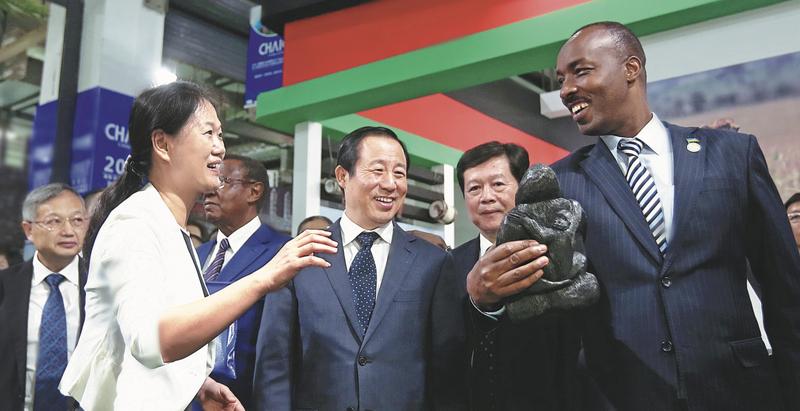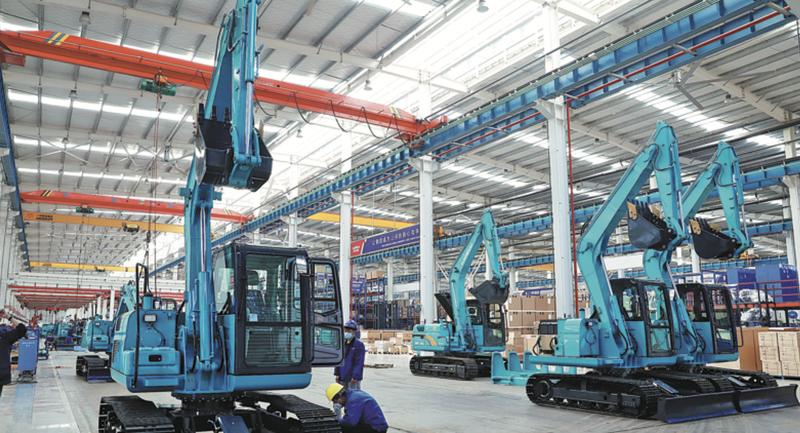 Xu Dazhe (third from right), Party secretary of Hunan, takes part in an agricultural industry exhibition held in the province. (PHOTO / CHINA DAILY)
Xu Dazhe (third from right), Party secretary of Hunan, takes part in an agricultural industry exhibition held in the province. (PHOTO / CHINA DAILY)
Central China’s Hunan province is reaping the rewards of an emphasis on foreign trade and opening-up, after the approval of a pilot free trade zone earlier this year.
Covering a total area of 119.76 square kilometers, the free trade zone comprises three sections in the Hunan capital of Changsha and the cities of Yueyang and Chenzhou
In the first three quarters, Hunan’s imports and exports grew by 6.9 percent year-on-year, which is 6.2 percentage points higher than that of the national average, according to the provincial government.
Located at the transition area of China’s eastern coastal region and the central and western regions, and the junction of the Yangtze River Economic Belt and the country’s coastal open economic belt, Hunan will make the most of its regional advantages, according to He Baoxiang, vice-governor of Hunan.
ALSO READ: Foreign enterprises 'should not worry' about export law
In late September this year, the China (Hunan) Pilot Free Trade Zone was approved, and is a major step for the province to boost trade and further open up.
Covering a total area of 119.76 square kilometers, the free trade zone comprises three sections in the Hunan capital of Changsha and the cities of Yueyang and Chenzhou.
 Attendees at the first China- Africa Economic and Trade Expo visit an equipment manufacturing plant in Hunan. (PHOTOS / CHINA DAILY)
Attendees at the first China- Africa Economic and Trade Expo visit an equipment manufacturing plant in Hunan. (PHOTOS / CHINA DAILY)
The Changsha section will focus on building an advanced manufacturing center, a high-tech industrial base and a modern service center connecting Guangdong, Hong Kong, Macao and the central region.
The Yueyang section is set to develop modern service industries such as shipping logistics and international trade and commerce, as well as high end manufacturing industries including electronic information, advanced equipment manufacturing, new materials and satellites.
The Chenzhou section will focus on developing the green economy and promote coordinated openness among Hunan, Guangdong, Hong Kong and Macao.
To seize major opportunities in the digital and intelligent industries, the China (Hunan) Pilot Free Trade Zone will promote the integration of advanced manufacturing and service industries, and aims to be deeply involved in the Belt and Road Initiative and international cooperation in production capacity, according to local officials.
To date, Hunan has set up 16 national economic development and high-tech industrial development zones, 123 provincial level economic development zones, seven customs supervision zones and 62 foreign trade service centers, offering strong support for the province’s development of foreign trade and its economy.
The first China-Africa Economic and Trade Expo was held in Changsha in June 2019, which helped the province reach a series of cooperation agreements with attendees from Africa.
According to the local government, the province signed 84 projects and agreements with more than 20 African countries, including Angola, Cote d’Ivoire and Senegal, with a contract value reaching US$20.8 billion.
 Diggers are assembled at a construction equipment manufacturer located in the Changsha section of the China (Hunan) Pilot Free Trade Zone. (PHOTO / CHINA DAILY)
Diggers are assembled at a construction equipment manufacturer located in the Changsha section of the China (Hunan) Pilot Free Trade Zone. (PHOTO / CHINA DAILY)
The contracted projects involve not only traditional sectors such as agriculture, mining, energy and infrastructure, but also industries outlining the future development between China and Africa, which include high-end manufacturing, e-commerce, aviation service and cultural tourism. As of now, Hunan has invested in more than 120 enter prises in Africa, with a total investment of nearly US$1 billion.
The second ChinaAfrica Economic and Trade Expo is scheduled to be held in September 2021 in Changsha, and is expected to further boost bilateral cooperation.
From January to October, Hunan’s imports and exports totaled 379.65 billion yuan (US$57.91 billion), an increase of 6.8 percent from the same period last year.
READ MORE: Tie-ups with private, foreign businesses to lift FDI inflows
From 2016 to 2019, the province experienced an average annual growth rate of 35.65 percent for its imports and exports.
By the end of 2019, more than 1,600 enterprises in Hunan had invested in 92 countries and regions around the world.
Zhu Youfang contributed to this story.



